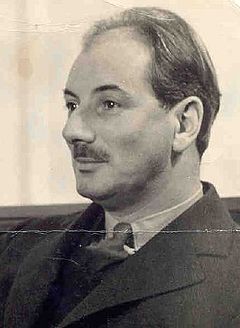Lewis Mumford facts for kids
Quick facts for kids
Lewis Mumford
|
|
|---|---|
 |
|
| Born | October 19, 1895 Flushing, New York, U.S. |
| Died | January 26, 1990 (aged 94) Amenia, New York, U.S. |
| Occupation |
|
| Nationality | American |
| Genre |
|
| Notable works | The City in History Technics and Civilization The Myth of the Machine |
| Notable awards | Leonardo da Vinci Medal (1969) |
Lewis Mumford (born October 19, 1895 – died January 26, 1990) was an American writer and thinker. He studied history, how societies work, and the role of technology. He was also a literary critic, meaning he wrote about books.
Mumford was especially known for his deep studies of cities and how they are built. He believed that cities should be designed to help people live better lives. He wrote many books and articles about social ideas, American culture, and the history of technology.
Contents
Life
Lewis Mumford was born in Flushing, New York. He finished high school in 1912. He went to college but had to stop because he became ill. In 1918, he joined the navy during World War I. He worked as a radio electrician.
After the war, in 1919, he started working for The Dial, a well-known literary magazine. Later, he wrote for The New Yorker magazine. There, he shared his ideas about architecture and city problems.
Mumford's early books were about American literature. In The Golden Day (1926), he wrote about famous American writers like Herman Melville and Walt Whitman. He believed these writers showed the spirit of America before the American Civil War. His book Herman Melville (1929) helped people rediscover Melville's works.
He also started writing about American architecture and city life. He looked at how buildings and cities reflected society. Mumford was good friends with psychologist Henry Murray. They often wrote letters to each other about many topics.
At first, Mumford was hopeful about new technologies like electricity. He thought they would help build a better world. But later, he became more concerned about the rapid changes brought by the second industrial revolution. He worried about their negative effects.
Mumford received many awards for his work. These included the Presidential Medal of Freedom in 1964. He also won the National Book Award in 1962 for his famous book, The City in History.
Lewis Mumford passed away at his home in Amenia, New York, when he was 94 years old. His house was later added to the National Register of Historic Places.
Ideas
Organic Humanism
In his 1944 book, The Condition of Man, Mumford described his way of studying people as "organic humanism." This idea means that human possibilities have limits. These limits are connected to our bodies and the natural world. Mumford always remembered how important things like clean air, good food, and comfortable spaces are. He believed these things must be respected for people to be healthy and happy.
He thought that technology and progress should not go too far. Organic humanism should act like a brake. It should stop technology from harming human well-being. Mumford believed that our brains are very active. This is good because it helps us solve problems. But it can be bad if our minds are not used in meaningful ways.
Mumford's respect for human "nature" helped him judge technologies. He believed that technology and cities should always serve human needs. He disagreed with thinkers like Marshall McLuhan. McLuhan thought technology would shape humans. Mumford saw this as a possible nightmare.
Technics
Mumford carefully chose the word "technics" in his writings. For him, technology is just one part of technics. The Greek word tekhne means more than just technology. It also means art, skill, and cleverness. So, "technics" means how society's ideas, habits, and goals mix with new inventions. It's about how people use tools and skills in their daily lives.
Megatechnics
In his 1970 book, The Pentagon of Power, Mumford criticized modern technology. He said it focuses too much on constant growth and making new things all the time. He called this "megatechnics." He believed these goals actually work against making things perfect or long-lasting.
Modern technology, he argued, often fails to make durable products. It uses things like consumer credit and planned obsolescence. This means products are designed to break or go out of style quickly. Mumford said that without constant advertising, production would slow down. Products could then reach a good design that would not need many changes each year.
He used his own refrigerator as an example. He said it worked for 19 years with only one small repair. He believed that if companies cared more about human needs than fashion, other products could be just as good.
Biotechnics
Mumford cared deeply about how technology affects life. He thought that many places on Earth were once full of life. But where certain technologies grew fast, life decreased. For example, polluted waters and concrete cities have very little life.
Mumford did not think this had to happen. He believed we could create technologies that work well with nature. He called this "biotechnics." Biotechnics means making technology that helps the environment and human life.
In a biotechnic society, people would not think technology must always expand. Instead, they would aim for "plenitude." This means a good balance between resources and needs. Technology would be limited by its possible negative effects on people and nature. Things like air quality, food quality, and water quality would be very important.
Mumford believed that a biotechnic society would aim for balance and completeness. It would focus on "qualitative richness" and freedom from too much pressure. He thought this way of thinking was already starting to appear in his time.
Polytechnics versus Monotechnics
A key idea from Mumford's 1934 book, Technics and Civilization, was that technology has two sides:
- Polytechnic: This uses many different types of technology. It creates a complex system to solve human problems.
- Monotechnic: This is technology used only for its own sake. It can make life harder for people as it grows without limits.
Mumford often criticized modern transportation in America. He said it was "monotechnic" because it relied too much on cars. Cars take up a lot of space and can be dangerous. He pointed out that many people are hurt or killed in car accidents each year. He saw this as a sacrifice society makes for relying too much on highways.
Three Epochs of Civilization
In Technics and Civilization, Mumford also divided human history into three main periods:
- Eotechnic: This was the time of the Middle Ages.
- Paleotechnic: This was the time of the Industrial Revolution.
- Neotechnic: This is the later, modern time.
Megamachines
Mumford also talked about "megamachines." These are very large, organized groups of people. They act like a machine, with humans as its parts. He said these megamachines appear throughout history. Examples include the builders of the Egyptian pyramids or large armies.
He believed that modern powerful countries, like the Soviet Union and the United States, also had megamachines. He pointed out that in these systems, leaders are often seen as very important. Also, there is a lot of focus on counting and rules.
Mumford worried that technology could make it easier for people to do bad things without feeling guilty. He used the example of Adolf Eichmann. Eichmann was a Nazi official who helped organize the Holocaust. Mumford called people who calmly carry out extreme goals of these megamachines "Eichmanns."
The Clock as Herald of the Industrial Revolution
One of Mumford's well-known ideas is about the mechanical clock. He studied how monks developed it in the Middle Ages. Then, the rest of society started using it. He believed the clock was the most important invention of the whole Industrial Revolution. Many people think the steam engine was most important. But Mumford wrote: "The clock, not the steam-engine, is the key-machine of the modern industrial age." He saw the clock as a machine that produces seconds and minutes.
Urban Civilization
Mumford's book The City in History won a major award in 1962. In this book, he explored how cities grew and changed. He strongly criticized urban sprawl, which is when cities spread out too much. Mumford argued that the way modern cities are built causes many social problems.
He believed that urban planning should focus on an "organic" relationship. This means people and their living spaces should connect naturally. Mumford used the example of medieval cities as an "ideal city." He worried that modern cities were too much like ancient Roman cities. Roman cities grew too big and then collapsed. Mumford feared modern cities might face the same fate.
He believed that cities are "a product of earth... a fact of nature... man's method of expression." Mumford also worried about the growing finance industry and political structures in cities. He feared they were not helping local communities. He wrote that the physical design of cities is less important than their connection to nature. He also felt that the spiritual values of human community were very important.
Influence
Mumford's ideas about the history of technology have influenced many thinkers. He helped people understand how technology should serve humans in the best ways possible. Some of these thinkers include Jacques Ellul and E. F. Schumacher.
Mumford also had a big impact on the American environmental movement. Thinkers like Barry Commoner were influenced by his ideas. These ideas were about cities, how living things interact with their environment (ecology), and technology. He wrote early and important ideas about protecting nature and using technology wisely.
His influence can also be seen in art. For example, Berenice Abbott's photographs of New York City in the 1930s show his ideas.
Works
- 1922 The Story of Utopias
- 1924 Sticks and Stones
- 1926 Architecture
- 1926 The Golden Day
- 1929 Herman Melville
- 1931 The Brown Decades: A Study of the Arts in America, 1865–1895
- "Renewal of Life" series
- 1934 Technics and Civilization
- 1938 The Culture of Cities
- 1944 The Condition of Man
- 1951 The Conduct of Life
- 1939 The City (film)
- 1939 Men Must Act
- 1940 Faith for Living
- 1941 The South in Architecture
- 1945 City Development
- 1946 Values for Survival
- 1952 Art and Technics
- 1952 Roots of Contemporary American Architecture
- 1954 In the Name of Sanity
- 1956 From the Ground Up (essay collection)
- 1956 The Transformations of Man
- 1961 The City in History (awarded the National Book Award)
- 1963 The Highway and the City (essay collection)
- The Myth of the Machine (two volumes)
- 1967 Technics and Human Development
- 1970 The Pentagon of Power
- 1968 The Urban Prospect (essay collection)
- 1979 My Work and Days: A Personal Chronicle
- 1982 Sketches from Life: The Autobiography of Lewis Mumford
- 1986 The Lewis Mumford Reader
See also
 In Spanish: Lewis Mumford para niños
In Spanish: Lewis Mumford para niños


